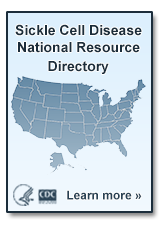Information for Hemophilia Treatment Centers (HTCs)
The Universal Data Collection (UDC) system is being carried out with the help of federally funded hemophilia treatment centers (HTCs) in the United States. Since the UDC system began in 1998, more than 24,000 people with bleeding disorders have participated in the activities of UDC. More than 80% of all people with hemophilia who receive care at these centers hasve participated in the UDC system.
As an HTC provider, your practice stands to benefit greatly from the findings generated by UDC. This system provides the most complete national portrait to date of the bleeding disorders population and its health complications. This information forms critical groundwork for future research to reduce and prevent these complications.

What to Expect
The UDC system works through a partnership between CDC and the HTCs.
CDC Responsibilities
CDC is committed to achieving UDC’s goals with as little disruption as possible to patient care. Input from HTCs will continue to be solicited to improve the program’s efficiency and effectiveness. Feedback, including sharing ongoing summaries of data, is a critical component. With input from the HTC and patient communities, CDC will pose questions for further study to develop effective strategies to reduce or eliminate the complications of bleeding disorders. Upon identification of seroconversions among patients consistent with a potential product safety issue, CDC will promptly launch an investigation and share the results with the bleeding disorders community. The results of these investigations may suggest safeguards that could decrease risks and improve the safety of blood products.
HTC Responsibilities
Each HTC must have trained professionals who can accomplish the following:
- Encourage Full Participation
A high degree of community participation is necessary for UDC to fulfill its goals. As an HTC team member, you can play a crucial role in this program by enrolling as many people as possible in UDC. - Provide Information
As an HTC provider, your role is to inform patients about UDC and, to the extent possible, answer their questions about the program. CDC has created an information packet for patients to help answer their questions about UDC. This packet includes a question-and-answer brochure and a brief fact sheet, both written in easy-to-understand language. You also must discuss the informed consent process with patients. - Obtain Consent
Patients agreeing to participate in UDC must provide written consent via a consent form. How you tailor this discussion is up to you; however, it is important that all eligible patients be given the opportunity to participate in the program and to have their questions and concerns answered as completely as possible. Parental consent is needed for participants younger than 18 years of age. Children younger than 18 but older than 7 years also sign an “assent” form to acknowledge their agreement to participate in UDC. - Collect routine clinical data using uniform data collection tools provided by CDC.
- Measure and record joint range of motion on appropriate patients. CDC has developed a video showing how to take these measurements and record the results correctly.
- Draw a blood sample and ship the specimen to CDC.
- Respond to queries for data validation from CDC and other authorized parties.
- Provide feedback to the regional coordinators and to CDC regarding study procedures and problems.
- Give test results to patients and offer counseling and/or medical management as necessary.
UDC Forms, Documents, and Resources »
UDC Data Reports
UDC data are available to HTC staff. Staff at each HTC can download electronic files containing UDC data collected from participants at their HTC and view reports of their center’s UDC data. In addition, national and regional reports of the data are available to HTC staff and the general public.
HTC Directory
Use the directory to search for the names and contact information of HTCs and staff, create lists, print mailing labels, and send emails.
Healthcare providers might use this directory to find and consult with other experts in the field. Patients might use this directory to obtain care when they are away from their usual care provider. It is important that the HTC directory has accurate information about your HTC. Please inform your regional coordinator of any changes in HTC staff or contact information so that the directory can be updated.

Patient Eligibility
All patients with an inherited coagulation factor deficiency of less than 50% of normal, including factor VIII (FVIII) or hemophilia A, FIX or hemophilia B, or FI, FII, FV, FVII, FX, FXI, FXIII OR a physician’s diagnosis of von Willebrand disease are eligible to participate in UDC.
Females Older Than 2 Years of Age
In certain HTCs, girls older than 2 years of age and women with bleeding disorders are eligible for the Female UDC Phase I. For females, the diagnostic criteria for eligibility are as follows:
- Inherited coagulation factor deficiency of less than 50% of normal, including FI, FII, FV, FVII, FVIII, FIX, FX, FXI, FXIII, OR PAI-1 or a2anti-plasmin deficiency
- Physician-diagnosed von Willebrand disease
- Inherited platelet disorder (for example, Glanzmann’s thrombasthenia, Bernard Soulier, Grey platelet syndrome, Hermanski-Pudlak syndrome, inherited thrombocytopenia, storage pool defect, platelet release defect)
- Connective tissue disorder (for example, suspected Ehlers-Danlos syndrome or hypermobility syndrome)
- Physician-diagnosed hereditary hemorrhagic telangiectasia (HHT), also sometimes referred to as Osler-Weber-Rendu (OWR)
Infants and Toddlers Younger Than 2 Years of Age
Boys and girls younger than 2 years of age should be enrolled in the Baby UDC. At age 2, all eligible male patients should be encouraged to participate in the regular UDC, and all eligible females two years of age or older should be encouraged to participate in the Female UDC Phase I where available.
UDC Data Collection Forms
|
Baby Registration Complete this form one time only for each eligible patient younger than 2 years of age with hemophilia, von Willebrand disease, or other congenital bleeding disorder when the first Baby Visit form is completed. |
View Form |
|
Baby Visit Complete this form at the first visit and at 6-month intervals for all visits made to the treatment center before 2 years of age. |
View Form |
|
Registration Complete this form one time only for each eligible patient 2 years old or older with hemophilia, von Willebrand disease, or other congenital bleeding disorder when the first Annual Form is completed. If you have submitted a Baby Registration form for the participant, you do not need to complete a Registration form. |
View Form |
|
Annual Visit Complete this form yearly for all consenting, eligible patients attending the treatment center. |
View Form |
|
Quality of Life Give this form to participants 14 years of age and older. Completion of this form is optional for UDC participants. Give this form to participants once per year at the annual visit. The form is designed to be completed by the participant without assistance by HTC staff and should not be reviewed by HTC staff. |
View Form |
|
Female Registration Complete this form at the first visit or to re-register females 2 years of age or older. (Note: Currently, only 19 HTCs are participating in the Female UDC Phase I Project. These forms will eventually be made available to the entire HTC network.) |
View Form |
|
Female Annual Visit Complete this form for all consenting, eligible female patients 2 years of age of older attending the treatment center on a yearly basis. (Note: Currently, only 19 HTCs are participating in the Female UDC Phase I Project. These forms will eventually be made available to the entire HTC network.) |
View Form |
|
Patient Refusal Complete this form once per year at the annual visit for each eligible patient who declines to participate in UDC. |
View Form |
|
Mortality Complete this form upon notification of death for any patient of any age who received any care in the hemophilia treatment center (HTC) and who fulfills the eligibility requirements for participation in UDC, whether or not the person actually participated in UDC. |
View Form |
Other UDC Documents and Resources
|
Model Patient Consent This is the model consent approved by the CDC Institutional Review Board (IRB) for the general UDC (not Inhibitor, not Female). Local IRBs may require additional information for individual HTC consents. |
View Form |
|
UDC Protocol This general protocol is reviewed annually by CDC’s Institutional Review Board (IRB). Any necessary amendments are included in this protocol. |
View Form |
|
Organizational Structure and Guidelines for the CDC Cooperative Studies This document addresses the collection and release of data gathered collaboratively throughout the cooperative agreements between HTCs and CDC in the prevention of complications of bleedings disorders. |
View PDF |
|
Testing Algorithms Algorithms for determining the sequence of tests performed on UDC blood samples. |
View Algorithms PDFView Testing Methods PDF |
|
Joint Range of Motion Video Learn how to accurately measure and collect joint range of motion for the UDC system. This video is intended for use by physical therapists or other health care providers at HTCs when they are collecting range of motion measurements. |
|
|
UDC Fact Sheet Information about the UDC Project for HTCs. |
View Fact Sheet |
|
Baby UDC Fact Sheet Information about the Baby UDC for HTCs. |
View Fact Sheet |
|
Female UDC Fact Sheet Information about the Female UDC for HTCs. |
View Fact Sheet |
|
UDC Inhibitor Project Fact Sheet Information about the Inhibitor Project for HTCs. |
View Fact Sheet |
|
Slide Set Distribution of UDC Males with Hemophilia in the U.S. – A Set of GIS Maps |
View slides |
|
UDC Supply Order Form Use this form to order supplies, such as data forms and shipping supplies. |
View form |
|
The Universal Data Collection (UDC) System: Lessons Learned and Future Directions This document provides information about recent research findings, current research projects, and future directions of the UDC System.Sistema de Recolección Universal de Datos (UDC): Lecciones aprendidas y dirección futura Este documento proporciona información sobre los resultados de investigaciones recientes, los proyectos actuales de investigación, y la orientación futura del Sistema de UDC. |
View and print English VersionView and print Spanish Version |
Submit Research Proposals
The UDC Working Group is seeking proposals from investigators with research questions that may be addressed using data collected as part of UDC. Investigators from any discipline are encouraged to submit proposals using the following template and instructions.
- Page last reviewed: March 22, 2017
- Page last updated: June 17, 2016
- Content source:



 ShareCompartir
ShareCompartir